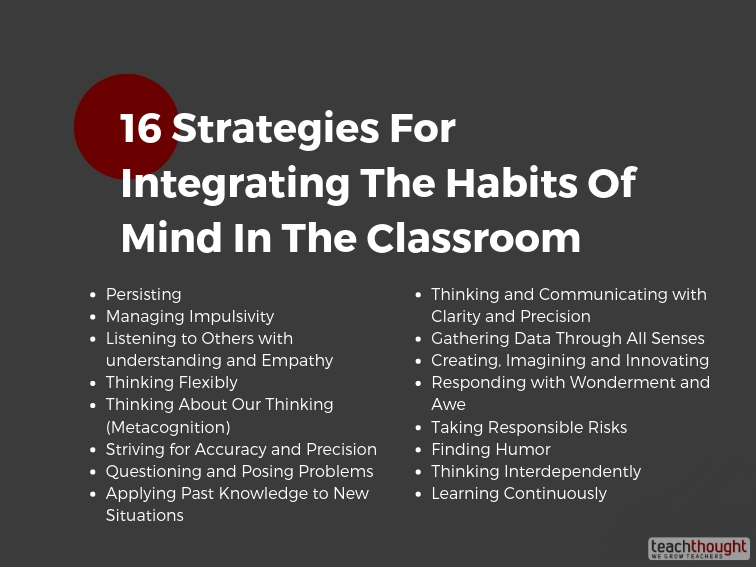
How Do You Use The Habits Of Mind In The Classroom?
In outcomes-based learning environments, we generally see three elements in play: 1) learning objectives or targets are created from given standards; 2) instruction of some kind is given; and then 3) learning results are assessed. These assessments offer data to inform the revision of further planned instruction. Rinse and repeat.
See also 4E Cognition: Integrating Mind, Body & Environment In Elementary Math
But lost in this clinical sequence are the Habits of Mind that (often predictably) lead to success or failure in the mastery of given standards. In fact, it is not in the standards or assessments, but rather these personal habits where success or failure–in academic terms–actually begin. Below are all 16 Habits of Mind, each with a tip, strategy or resource to understand and begin implementation in your classroom.
See also What Are The Habits Of Mind?
The habits themselves aren’t new at all, and significant work has already been done in the areas of these ‘thinking habits.’ However, in a 21st-century learning environment — one often inundated with information, stimulation, and connectivity — there may be a newfound context for their application.
And a renewed urgency for their integration.
The Habits of Mind (by Art Costa and Bena Kallick) don’t simply represent fragments of practice to ‘add on’ to what you already do, but rather new ways to think about how people learn.
16 Strategies For Integrating The Habits Of Mind In The Classroom
1. Persisting
Have students identify characteristics of persistence shown by individuals in well-known events, or imagine what might have occurred if more or less persistence was shown in a given scenario.
2. Managing Impulsivity
Model the use of patience in the classroom, including wait time during discussion, or using helpful sentence stems that reflect intentional choice (such as “After reviewing all of the possible solutions . . . “).
3. Listening to Others with Understanding and Empathy
Identify the most common ‘listening set-asides’ in conversation so that students can begin to recognize common ‘errors’ that occur in everyday communication. These errors might include comparing, judging, placating, or giving advice instead of really listening and understanding a message.
4. Thinking Flexibly
Use RAFT assignments (Role, Audience, Format, Topic) where students must consider a situation, letter, speech or poem from a perspective other than their own, or that of the original speakers.
5. Thinking About Our Thinking (Metacognition)
Ask students to map out their own thinking processes. This can be done simply at first, e.g., diagramming the relationship between a want and a need, a gesture and a need to gesture. Then make it increasingly complex — mapping out how characters from books or thinkers in history might have arrived at certain starting or stopping points in thought.
6. Striving for Accuracy and Precision
Use ‘three before me,’ a strategy that insists on any important assignment being checked by at least three other people before being handed in.
7. Questioning and Posing Problems
Create a ‘parking lot’ area in the classroom — stocked with post-it notes — where students can post questions that may not fit into the pace or format of a given class. Then highlight the better questions periodically, or use them as jumping-off points for discussion or even lesson planning.
8. Applying Past Knowledge to New Situations
Use question stems like “What do you remember about . . . ?”, “When have you ever seen anything like this?” or “Tell me what you know about . . . ” Whether you consider this activating schema, prior knowledge, or simply getting students more comfortable and in tune with what they already know, it can be a huge boost to the learning process.
9. Thinking and Communicating with Clarity and Precision
Remind students to avoid the vagueness and abstraction — and imprecision — of terms like always, never, all, everybody, teachers, celebrities, technology, they, we, should and must. Post these kinds of words or phrases where students can be reminded of them — and know to avoid them. And hopefully know why they should avoid them.
10. Gathering Data Through All Senses
Playfully allow students to ‘cite’ sources from sensory data in addition to traditional textual sources. Also consider including the compelling use of such data in a rubric for formal assessment.
11. Creating, Imagining and Innovating
Offer persistent sources of inspiring thought, design, art or multimedia through writing prompts, discussion points or simply as a daily class closure. This models not only creativity, but also expertise, and is readily available on YouTube, Pinterest, and Instagram.
12. Responding with Wonderment and Awe
Don’t just allow opportunities for student choice in topics, formats or learning pathways — insist on it. Refuse to move the class forward until they are bringing their own passions into the learning experience.
13. Taking Responsible Risks
Create an environment where failure is analyzed, not punished.
14. Finding Humor
Point out humor where it is not immediately apparent, especially in stories and examples from your own life. This can help establish the ‘relativity’ of ‘things,’ which supports more accurate analysis. Humor makes everything better.
15. Thinking Interdependently
Using digital and social media imposes at least a topical need for interdependence from the beginning. The more thinking is published and shared, the more opportunity there will be for cognitive interdependence, though even opportunities don’t guarantee that it will happen.
16. Learning Continuously
Intermittently revisit old ideas, writing, and projects to identify areas for development, improvement, or revision. This is especially natural in digital domains, where content is more fluid — updated, shared, hyperlinked, curated, reformatted into more or less visual terms, then shared again.
I know that these are just the tip of the iceberg and that there are many approaches one can take. Which of these Habits of Mind needs the most support for your students? How do you integrate these habits into your classroom?
This post was originally written by Terry Heick for edutopia.org
